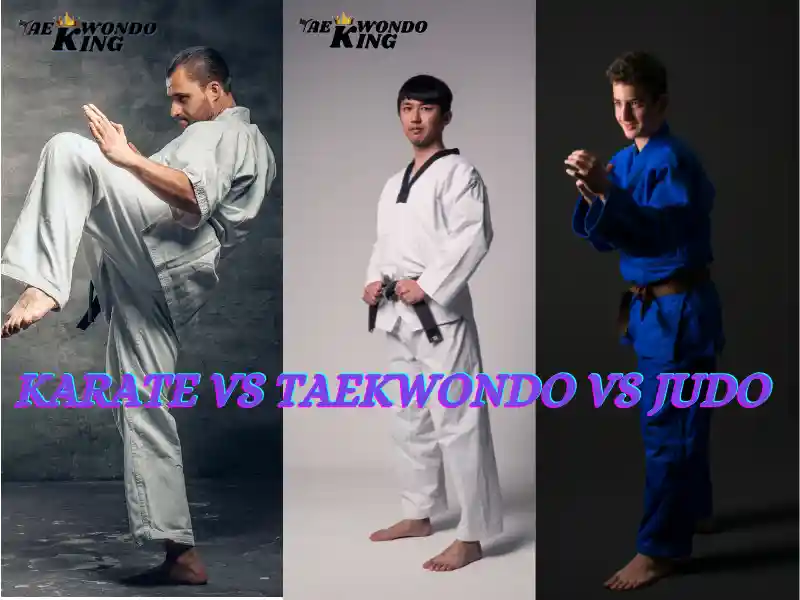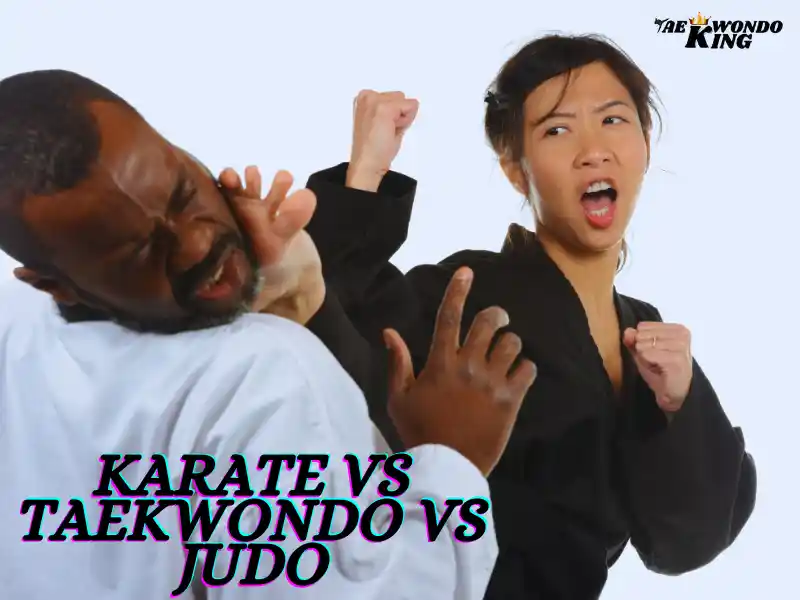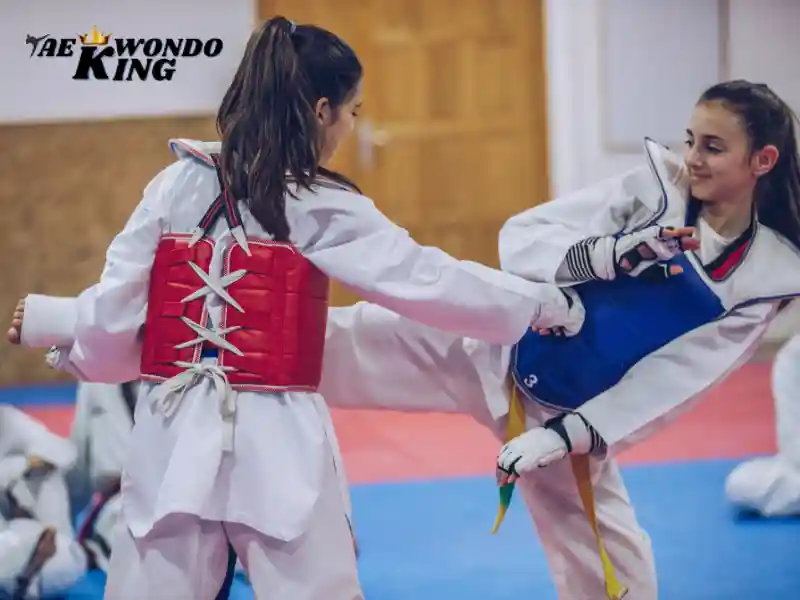
Martial arts have been an integral part of human culture for centuries, encompassing a wide range of styles and techniques that have evolved over time. Among the most popular and widely practiced martial arts are Karate, Taekwondo, and Judo. Each of these disciplines has its unique characteristics, philosophy, and techniques, making them distinct yet interconnected. In this article, we delve into the world of Karate, Taekwondo, and Judo to understand their origins, techniques, philosophies, and the differences that set them apart. Learn Karate vs. Taekwondo vs. Judo, Who is the better?
When you first begin to learn martial arts, it may seem like there are a lot of differences between them. However, after you learn more about them, you’ll find that there are many similarities. The main difference between the three martial arts is the focus. In judo, you focus on self-defense. If look karate, you focus on defending others. In taekwondo, you focus on improving your self-defense.
In addition, taekwondo is more aggressive than judo, karate, or kickboxing. Karate and kickboxing are both full-contact sports, so they involve striking and kicking. Taekwondo involves some striking, but it isn’t as violent as either of these two martial arts. Judo involves a lot of throwing and takedowns. The movements used in karate and kickboxing are similar to the moves used in judo. Kickboxing is more aggressive than karate. It uses punches and kicks aggressively. Kata (or forms) are used in kickboxing and karate. Kata in karate is used to train your fighting skills. These martial arts are all effective ways of defending yourself. They all work well against attackers. However, some are better than others.
Karate vs Taekwondo vs Judo, Origins and Histories

Taekwondo:
Taekwondo, on the other hand, hails from Korea and is known for its high-flying kicks and dynamic, flashy techniques. The name “Taekwondo” is derived from three Korean words: “Tae” (foot), “Kwon” (fist), and “Do” (way). Developed after Korea’s liberation from Japanese occupation in the mid-20th century, Taekwondo was influenced by traditional Korean martial arts, Karate, and Chinese martial arts. It gained international recognition and became an official Olympic sport in 2000. You can be looking for a taekwondo world champion and a taekwondo summer camp.
Karate:
Karate, originating in the Ryukyu Kingdom (now Okinawa, Japan), is a striking-based martial art that emphasizes using punches, kicks, knee strikes, and elbow strikes. It was influenced by indigenous Okinawan fighting styles and Chinese martial arts. The word “Karate” translates to “empty hand,” signifying its focus on unarmed combat. It wasn’t until the early 20th century that Karate was introduced to Japan, where it underwent further development and spread internationally.
Judo:
Judo, unlike striking-oriented Karate and Taekwondo, is a Japanese martial art that focuses on throws, pins, joint locks, and chokeholds to control opponents. Created by Jigoro Kano in the late 19th century, Judo’s primary philosophy is the efficient use of an opponent’s force rather than opposing it directly. Judo practitioners, known as judokas, emphasize balance, leverage, and timing to overcome larger and stronger opponents.
Karate vs Taekwondo vs Judo, Techniques and Training
Taekwondo:
Taekwondo places a strong emphasis on kicks, including high, jumping, and spinning kicks. Practitioners also learn hand strikes, blocks, and patterns (forms known as poomsae). Taekwondo training involves extensive flexibility and agility exercises to execute swift and precise kicks. taekwondo kicks are very important in Training. Also, Taekwondo gi, taekwondo uniform, taekwondo belts, and taekwondo ranks are essential in taekwondo classes in a taekwondo academy. Sparring is a vital component of Taekwondo training, allowing practitioners to apply their techniques in a controlled combat setting. The art promotes self-discipline, respect, and perseverance.
Karate:
Karate training involves a combination of katas (pre-arranged forms), sparring, and striking drills. Practitioners develop powerful strikes, blocks, and counterattacks, with an emphasis on generating maximum force and speed. Karatekas also learn to use various parts of their body for striking, including fists, palms, elbows, and knees. Training in Karate promotes discipline, mental focus, and self-defense skills.
Judo:
Judo training centers around throwing groundwork and submissions. Judokas practice a wide range of throws that aim to unbalance opponents and bring them to the ground. Once on the ground, practitioners utilize pins, joint locks, and chokeholds to immobilize or submit their adversaries. Judo training enhances physical strength, balance, and timing. The art’s focus on controlled techniques and mental resilience cultivates patience, adaptability, and respect for one’s opponent.
Karate vs Taekwondo vs Judo, Philosophies and Principles
Taekwondo:
Taekwondo’s philosophy revolves around the development of an indomitable spirit and a strong moral character. The tenets of Taekwondo include courtesy, integrity, perseverance, self-control, and an unyielding spirit. Practitioners of Taekwondo seek harmony between mind and body, pursuing not only physical excellence but also a deeper understanding of themselves and their surroundings.
Karate:
Karate embodies the principles of respect, humility, and self-discipline. Practitioners strive for self-improvement and personal growth, aiming to achieve a balance between physical prowess and mental clarity. The philosophy of Karate extends beyond the dojo, emphasizing ethical behavior, integrity, and responsible use of acquired skills.
Judo:
Judo’s philosophy is encapsulated in the concept of “Jita Kyoei,” which translates to “mutual benefit and welfare.” Judo places importance on using one’s skills for the betterment of society and promoting cooperation rather than aggression. Judokas learn to overcome obstacles through adaptability and intelligent application of technique, embodying the principle of maximum efficiency with minimal effort.
Karate vs Taekwondo vs Judo, Competition and Sports Aspects
Karate:
Martial art Karate competitions involve point-based sparring, where competitors earn points for strikes delivered to specific target areas. The objective is to accumulate points through clean and controlled techniques. Karate’s inclusion in the Olympic Games since 2020 reflects its status as a respected international sport.
Taekwondo:
Taekwondo sparring heavily emphasizes kicks and uses a point-based system similar to Karate. The distinctive use of head kicks and dynamic techniques adds a visually appealing aspect to Taekwondo competitions. The World ranking is very important for the next taekwondo summer camp and taekwondo world champion. The sport’s Olympic inclusion has further propelled its popularity and global recognition.
Judo:
Judo competitions focus on throws, pins, and submissions. The objective is to throw an opponent onto the mat with force and control or to immobilize them for a specified period. Judo’s competitive format encourages strategy, timing, and precision. It has been an Olympic sport since 1964 and continues to captivate audiences with its dynamic throws and ground techniques.
What are the key differences between Karate, Taekwondo, and Judo?
Karate, Taekwondo, and Judo are distinct martial arts with their own set of characteristics. Here are some important differences between them:
1. Origins: Karate originated in Okinawa, Japan, while Taekwondo originated in Korea, and Judo originated in Japan.
2. Techniques: Karate focuses on strikes, kicks, and punches, emphasizing powerful and precise movements. Taekwondo primarily focuses on high and fast kicks, which are known for their impressive nature. Judo emphasizes grappling and throwing techniques.
3. Philosophy: Karate emphasizes self-defense, discipline, and personal development. Taekwondo emphasizes discipline, self-control, and the development of a strong mind and body. Judo focuses on maximum efficiency and using an opponent’s strength against them.
4. Competitive Aspect: Karate has both kata (forms) and kumite (sparring) competitions. Taekwondo also includes forms and sparring, with a strong emphasis on high kicks. Judo primarily focuses on sparring and aims to throw opponents onto their backs for victory.
5. Uniforms: Karate practitioners wear a gi (karate uniform) with a colored belt system to indicate rank. Taekwondo practitioners also wear a gi, but they have colored belts and dobok (uniform) with a v-neck jacket. Judo practitioners wear a judogi, a heavy cotton jacket, and pants, with a belt system indicating rank.
These are just a few of the key differences, and each martial art has its own unique techniques, training methods, and philosophies.
What are the similarities between Karate, Taekwondo, and Judo?
Karate, Taekwondo, and Judo are martial arts forms that originated in East Asia. These martial arts focus on discipline, physical fitness, and self-defense techniques. They include striking, blocking, throws, and grappling techniques. Mental and spiritual growth, respect, self-control, and perseverance are also emphasized. Furthermore, they are recognized as Olympic sports and have international governing bodies to oversee their practice and competitions.
Which martial art is best for self-defense: Karate, Taekwondo, or Judo?
The best martial art for self-defense ultimately depends on individual preferences, goals, and circumstances. All three martial arts mentioned (Karate, Taekwondo, and Judo) have their strengths and can be effective for self-defense purposes. It is recommended to research and try out different martial arts to find the one that suits you best. Additionally, self-defense training should also include situational awareness, verbal de-escalation techniques, and knowledge of self-defense laws.
What are the main goals and philosophies behind Karate, Taekwondo, and Judo?
Karate, Taekwondo, and Judo are all martial arts that have distinct objectives and philosophies.
Karate: The primary aim of Karate is self-defense. It focuses on striking techniques involving punches, kicks, knee strikes, and elbow strikes. Karate also places great importance on discipline, respect, and self-control. Its philosophy is based on the principles of humility, perseverance, and continuous self-improvement.
Taekwondo: Taekwondo is renowned for its dynamic and high kicks. Its main objective is to develop physical and mental strength, along with self-defense skills. Taekwondo also promotes self-discipline, respect for others, and the pursuit of excellence. Its philosophy is rooted in the five tenets of courtesy, integrity, perseverance, self-control, and indomitable spirit.
Judo: Judo is a grappling martial art that concentrates on throws, joint locks, and chokeholds. Its primary goal is to utilize an opponent’s energy against them rather than relying solely on physical strength. Judo also emphasizes mutual respect, personal development, and the concept of maximum efficiency with minimal effort. Its philosophy is based on the principles of mutual welfare and benefit, as well as the pursuit of personal and social development through training.
Each martial art has its own unique techniques, training methods, and philosophies, but they all share the common goal of self-improvement and personal growth.
Which martial art should I choose between Karate, Taekwondo, and Judo?
The decision between Karate, Taekwondo, and Judo ultimately depends on your personal preferences and goals. Here is a brief overview of each martial art:
Karate:
Known for its striking techniques, Karate focuses on punches, kicks, and knee strikes. It also includes forms or patterns called katas and emphasizes self-defense. Karate can be a good choice if you are interested in striking techniques and self-defense.
Taekwondo:
Taekwondo is a Korean martial art that primarily focuses on high, fast kicks and jumping and spinning kicks. It also includes hand strikes and blocks. Taekwondo is known for its emphasis on agility, flexibility, and speed. It can be a good choice if you are interested in kicking techniques and Olympic-style sparring.
Judo:
Judo is a Japanese martial art that primarily focuses on throws and grappling techniques. It emphasizes using an opponent’s strength against them and using leverage and technique rather than brute force. Judo can be a good choice if you are interested in self-defense, throws, and ground fighting.
Ultimately, it is recommended to try out classes or talk to instructors of each martial art to see which one resonates with you the most. It’s important to consider your goals, fitness level, and what you enjoy most to make an informed decision.
What techniques are commonly used in Karate, Taekwondo, and Judo?
In Karate, the typical techniques involve using punches, kicks, knee strikes, elbow strikes, and open-hand techniques. Taekwondo emphasizes executing high, fast kicks and jumping and spinning kicks. Judo primarily emphasizes throwing techniques, grappling, and ground fighting. Some of the common techniques in Judo include throws, holds, joint locks, and chokes.
What are the differences and similarities between Karate and Taekwondo?
Taekwondo and Karate are two martial arts that originated in East Asia, but they have some differences. Karate originated in Okinawa, Japan, and was influenced by Chinese martial arts, while Taekwondo originated in Korea. Karate focuses on strikes, punches, and kicks, while Taekwondo emphasizes high, fast kicks and acrobatic movements. Both martial arts have forms or patterns that practitioners learn and perform, but Karate forms tend to have more linear movements, while Taekwondo forms involve dynamic kicks.
In terms of competition rules, Karate has different styles and organizations with their own rules, while Taekwondo has standardized rules for point sparring, form competition, and breaking techniques. However, there are also similarities between Karate and Taekwondo, such as teaching self-defense techniques, emphasizing discipline and respect, using a belt ranking system, and involving physical conditioning and partner drills in training. It’s important to note that there are variations within each martial art, so techniques and philosophies may vary depending on the school or organization.
What are the differences and similarities between Karate and Judo?
Both Karate and Judo are martial arts that originated in Japan. However, there are some differences and similarities between the two:
1. Origins: Karate originated in Okinawa, while Judo was developed in Japan by Jigoro Kano.
2. Techniques: Karate primarily focuses on strikes using punches, kicks, knee strikes, and elbow strikes. Judo, on the other hand, emphasizes throws, grappling, and submission techniques.
3. Competition: Karate has different styles and competitions, such as kata (forms) and kumite (sparring). Judo competitions mainly revolve around throws, pins, and submissions.
4. Uniform: Karate practitioners wear a gi (uniform) that consists of a loose-fitting jacket and pants, while Judo practitioners wear a thicker gi for more gripping during throws.
5. Philosophy: Karate places an emphasis on self-defense and personal development, focusing on discipline and mental training. Judo also values discipline and personal development but emphasizes the principle of “maximum efficiency with minimum effort.”
Despite these differences, both Karate and Judo teach respect, discipline, and self-control. Both martial arts require dedication, practice, and physical fitness.
What are the differences and similarities between Taekwondo and Judo?
Taekwondo and Judo are two martial arts that have distinct differences and similarities.
Differences:
1. Origin: Taekwondo originated in Korea, while Judo originated in Japan.
2. Techniques: Taekwondo focuses on high, fast kicks and strikes, while Judo emphasizes throws, grappling, and ground fighting.
3. Uniform: Taekwondo practitioners wear a dobok (uniform) with a colored belt system, while Judo practitioners wear a judogi (uniform) with a belt system that indicates rank.
4. Competition: Taekwondo competitions involve point sparring, breaking boards, and patterns (forms), while Judo competitions involve throwing opponents to the ground and immobilizing them with pins or submissions.
Similarities:
1. Etiquette: Both Taekwondo and Judo emphasize discipline, respect, and proper etiquette.
2. Self-defense: Both martial arts teach practical self-defense techniques.
3. Philosophy: Both arts promote personal development, mental focus, and physical fitness.
4. Belt System: Both arts use a colored belt system to indicate rank and progression.
Overall, Taekwondo emphasizes striking techniques and high kicks, while Judo focuses on grappling and throws. However, both martial arts share common principles of discipline, respect, and personal growth.
Karate vs. Taekwondo vs. Judo, Choosing the Right Path
Deciding between Karate, Taekwondo, and Judo depends on individual preferences, goals, and inclinations. Each martial art offers a unique journey of self-discovery, physical conditioning, and personal growth.
If you’re drawn to disciplined striking techniques and the harmony of mind and body, Karate might be your choice. Taekwondo enthusiasts, on the other hand, are often captivated by the art’s emphasis on dynamic kicks, athleticism, and moral values. For those intrigued by the art of balance, leverage, and controlled throws, Judo presents an avenue to explore.
Ultimately, the path you choose should resonate with your values, aspirations, and interests. Whichever martial art you embark upon, the journey promises to be one of growth, self-improvement, and an appreciation for the rich tapestry of martial arts traditions.
In conclusion,
Karate, Taekwondo, and Judo each bring their own unique philosophies, techniques, and training methodologies to the world of martial arts. While they differ in their approaches, they all share the common goal of cultivating physical prowess, mental fortitude, and ethical conduct. Whether you’re drawn to the power of strikes, the artistry of kicks, or the finesse of throws, each of these martial arts offers a fulfilling and transformative journey for practitioners of all ages and backgrounds.

Founder, Owner, and CEO of TaekwondoKing.
He is one of the top 100 martial artists in the World and among the top 20 referees in Bangladesh.
Ehatasamul Alom is an esteemed Kukkiwon Certified Taekwondo 3rd Dan Black Belt with over 15 years of experience in this dynamic martial art. Born in Rajshahi, Bangladesh, Ehatasamul’s journey with Taekwondo began at the tender age of seven. His passion led him to compete at national and international levels, where he has bagged numerous awards and honors. He is also a member of the Taekwondo National Referee Panel.
With a Bachelor’s degree in Sports Science from the prestigious Rajshahi University, Ehatasamul has a deep understanding of the technical and scientific aspects of martial arts and some other martial arts.
In 2022, Ehatasamul created the “TaekwondoKing.com” blog to share his knowledge and Real experiences. His articles focus on Taekwondo training techniques, competition strategies, and the art’s rich history and philosophy. He also writes about the importance of mental fortitude and discipline, key aspects of his teaching philosophy. His goal is to inspire both beginners and seasoned practitioners worldwide through insightful and engaging content.
If you need any help, contact Ehatasamul Alom at any time.




